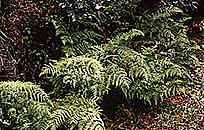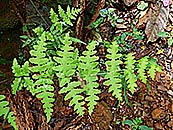Histiopteris incisa (Thunb.) J.Sm.
Synonyms |
Pteris incisa Thunb. |
|---|---|
Common name |
|
Description |
Rhizome subterranean, creeping, c.6 mm diameter; rhizome scales midbrown, lanceolate in outline, apex tapering to a point, 1-3 mm long, sometimes interspersed with brown hairs. Fronds widely spaced, erect to arching, glabrous on both surfaces, herbaceous, glaucous-green. Stipe up to 60 cm long, glabrous, purplish to pale chestnut brown, but darker brown with scattered scales near the base. Lamina 2 × 1 m, ovate-lanceolate in outline, deeply 2 to 3-pinnatifid. Pinnules incised almost to the costules, margins entire, ultimate lobes roughly oblong with rounded apices. A pair of reduced pinnules is present at the junction of the rhachis and secondary rhachis. Rhachis reddish to pale brown, circular in cross section, glabrous. Sori up to 1 mm broad, linear or rarely lunulate, borne along the margins but absent at the apex and in the sinuses; pseudo-indusium membranous, entire. |
Notes | |
Derivation | incisa: incised, referring to the deeply incised pinnules. |
Habitat | In forest margins or clearings, along streams, seepage zones or roadsides, exposed or in light shade, Hypericum woodland, Podocarpus bamboo and giant heath Hagenia forest and woodland. |
Distribution worldwide | Central and tropical Africa, pantropical and extending to the southern temperate and subantarctic islands. |
Distribution in Africa |
Angola, Burundi, Cameroon, Congo, Dem. Republic of Congo, Equatorial Guinea (incl. Bioko), Gabon, Guinea, Ivory Coast, Kenya, Liberia, Malawi, Rwanda, Sierra Leone, South Africa, Tanzania , Uganda, Zambia, Zimbabwe. |
Growth form |
Terrestrial. |
Literature |
|



